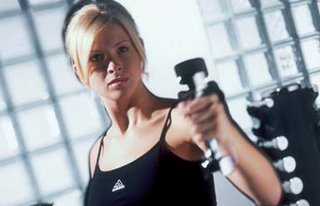Conjugated Linoleic Acid (CLA) flat out works. If you take this as directed, you will lose fat even if you change nothing else in your program. But you get outstanding results if you take this and follow our proven fat loss principles.
Lose fat while you sleep, with Nitro GH Night-time Fatburner Burn fat with Nitro Burn Extreme� All Natural "Ephedra Free" Fat Burner
SuppleCity sells only a few of the many fatburner supplements on the market. We sell ones that work--not all of them do.
Chromium supplements help only if you have a chromium deficiency--which is rare. See your doctor if you suspect such a deficiency--it's a sign of other problems.
Fatburners and thermogenics don't do magic, but they will help you get off a fat plateau. If you want to kick your "get lean" program into high gear, take fatburners for a month. You will get results.
Glutamine is also helpful for recovery and muscle growth, and taking it with HMB provides outstanding results.
Using glutamine, you can expect to cut your recovery time from squats in half. Not only will you feel better in the days that follow heavy workouts, but you will also see improved results from your exercise program.
Labrada Nutrition Instant Breakfast Shake, Banana
Meal replacement powders (MRPs) are the ultimate supplement for a sustained nutrition program. They form the foundation for the rest of your program.
We like Optimum Nutrition's products, and we also like Lee Labrada's products. I am able to maintain my body fat between 6% and 7% using these products.
Pack on muscle with delicious Nitro XP Protein Blend, 2lbs, Vanilla
Protein powders are easy enough to find, and we carry only the ones that do what they claim to do. The typical athlete needs about 1 gram of protein per pound of body weight. My own blood tests showed that even this much was barely enough for me. The typical American needs less than half that amount. If you're a serious athlete, be serious about your protein.
Creatine helps muscles contract harder during recovery, and then aids in recovery. The result? Bigger, stronger muscles.
Creatine is ideal for the serious, hard-training athlete. Extensive studies have been done with creatine supplementation for the non-athlete, and the results have been very positive. You can't go wrong with creatine. If you're not training hard, though, it's a waste of money.
Promax Carb Conscious Bars, Cookies 'n Cream flavor
Protein bars give you nearly all the benefits of protein powders, in a portable form. That is, if you choose the right bars.
The sheer number of bars is mind-boggling, and most of them are junk. We carry only the ones that support a lean and strong body.
Lose fat while you sleep, with Nitro GH Night-time Fatburner Burn fat with Nitro Burn Extreme� All Natural "Ephedra Free" Fat Burner
SuppleCity sells only a few of the many fatburner supplements on the market. We sell ones that work--not all of them do.
Chromium supplements help only if you have a chromium deficiency--which is rare. See your doctor if you suspect such a deficiency--it's a sign of other problems.
Fatburners and thermogenics don't do magic, but they will help you get off a fat plateau. If you want to kick your "get lean" program into high gear, take fatburners for a month. You will get results.
Glutamine is also helpful for recovery and muscle growth, and taking it with HMB provides outstanding results.
Using glutamine, you can expect to cut your recovery time from squats in half. Not only will you feel better in the days that follow heavy workouts, but you will also see improved results from your exercise program.
Labrada Nutrition Instant Breakfast Shake, Banana
Meal replacement powders (MRPs) are the ultimate supplement for a sustained nutrition program. They form the foundation for the rest of your program.
We like Optimum Nutrition's products, and we also like Lee Labrada's products. I am able to maintain my body fat between 6% and 7% using these products.
Pack on muscle with delicious Nitro XP Protein Blend, 2lbs, Vanilla
Protein powders are easy enough to find, and we carry only the ones that do what they claim to do. The typical athlete needs about 1 gram of protein per pound of body weight. My own blood tests showed that even this much was barely enough for me. The typical American needs less than half that amount. If you're a serious athlete, be serious about your protein.
Creatine helps muscles contract harder during recovery, and then aids in recovery. The result? Bigger, stronger muscles.
Creatine is ideal for the serious, hard-training athlete. Extensive studies have been done with creatine supplementation for the non-athlete, and the results have been very positive. You can't go wrong with creatine. If you're not training hard, though, it's a waste of money.
Promax Carb Conscious Bars, Cookies 'n Cream flavor
Protein bars give you nearly all the benefits of protein powders, in a portable form. That is, if you choose the right bars.
The sheer number of bars is mind-boggling, and most of them are junk. We carry only the ones that support a lean and strong body.
